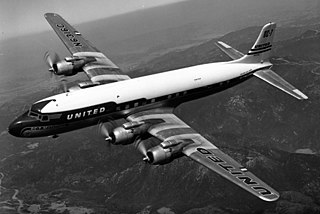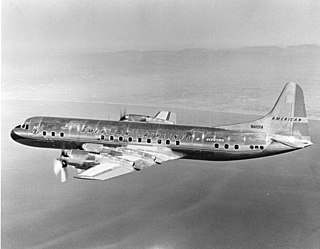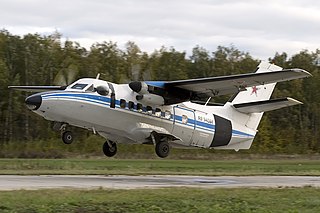Eastern Air Lines, also colloquially known as Eastern, was a major airline in the United States that operated from 1926 to 1991. Before its dissolution, it was headquartered at Miami International Airport in an unincorporated area of Miami-Dade County, Florida.

The Tenerife airport disaster occurred on 27 March 1977, when two Boeing 747 passenger jets collided on the runway at Los Rodeos Airport on the Spanish island of Tenerife. The collision occurred when KLM Flight 4805 initiated its takeoff run during dense fog while Pan Am Flight 1736 was still on the runway. The impact and resulting fire killed all on board KLM Flight 4805 and most of the occupants of Pan Am Flight 1736, with only 61 survivors in the front section of the aircraft. With a total of 583 fatalities, the disaster is the deadliest accident in aviation history.

The Douglas DC-7 is an American transport aircraft built by the Douglas Aircraft Company from 1953 to 1958. A derivative of the DC-6, it was the last major piston engine-powered transport made by Douglas, being developed shortly after the earliest jet airliner—the de Havilland Comet—entered service and only a few years before the jet-powered Douglas DC-8 first flew in 1958. Larger numbers of both DC-7B and DC-7C variants were also built.

On December 16, 1960, a United Airlines Douglas DC-8 bound for Idlewild Airport in New York City collided in midair with a TWA Lockheed L-1049 Super Constellation descending toward LaGuardia Airport. The Constellation crashed on Miller Field in Staten Island and the DC-8 in Park Slope, Brooklyn, killing all 128 aboard the two aircraft and six people on the ground. The accident was the world's deadliest aviation disaster at the time, and remains the deadliest accident in the history of United Airlines.

Air China Flight 129 (CCA129/CA129) was a scheduled international passenger flight, operated by Air China, from Beijing Capital International Airport to Gimhae International Airport in Busan. On 15 April 2002, the aircraft on this route, a Boeing 767-200ER, crashed into a hill near the airport, killing 129 of the 166 people on board.

American Airlines Flight 320 was a scheduled flight between Chicago Midway Airport and New York City's LaGuardia Airport. On February 3, 1959, the Lockheed L-188 Electra performing the flight crashed into the East River during its descent and approach to LaGuardia Airport, killing 65 of the 73 people on board. Weather conditions in the area were poor, and the aircraft descended through dense clouds and fog. As it approached the runway, it flew lower than the intended path and crashed into the icy river 4,900 feet (1,500 m) short of the runway. American Airlines had been flying the newly-developed Lockheed Electra in commercial service for only about two weeks before the accident, and the accident was the first involving the aircraft type.

Continental Airlines Flight 1713 was a commercial airline flight that crashed while taking off in a snowstorm from Stapleton International Airport in Denver, Colorado, on November 15, 1987. The Douglas DC-9 airliner, operated by Continental Airlines, was making a scheduled flight to Boise, Idaho. Twenty-five passengers and three crew members died in the crash.

American Airlines Flight 157, a Douglas DC-6, departed on November 29, 1949, from New York City bound for Mexico City with 46 passengers and crew. After one engine failed in mid-flight, a series of critical mistakes by the flight crew caused the pilot to lose control of the plane during the final approach to a routine stopover at Love Field in Dallas, Texas. The airliner slid off the runway and struck a parked airplane, a hangar, and a flight school before crashing into a business across from the airport. 26 passengers and two flight attendants died. The pilot, co-pilot, flight engineer, and 15 passengers survived.

Linjeflyg Flight 267V was a controlled flight into terrain by a Convair 440-75 Metropolitan on 20 November 1964 at 21:14 in Ängelholm, Skåne, Sweden. The Linjeflyg pilots, misled by a non-conventional military runway light configuration, descended too early and on a faulty course during approach to Ängelholm–Helsingborg Airport. The crash killed 31 of 43 people on board, making it the deadliest aviation accident in Sweden.

On 17 February 1959, a Turkish Airlines Vickers Viscount Type 793 on an international charter flight from Esenboğa International Airport in Ankara, Turkey, to London Heathrow Airport diverted to London Gatwick Airport, United Kingdom due to heavy fog. It was carrying the Turkish prime minister and a party of government officials. The Viscount crashed in a wood 3 miles (4.8 km) from the threshold of Gatwick runway during its final approach to land in extensive fog. Five of the eight crew and nine of the 16 passengers died in the crash. The prime minister was among the ten survivors.

The 1990 Wayne County Airport runway collision involved the collision of two Northwest Airlines jetliners at Detroit Metropolitan Wayne County Airport on December 3, 1990. Flight 1482, a scheduled Douglas DC-9-14 operating from Detroit to Pittsburgh International Airport, taxied by mistake onto an active runway in dense fog and was hit by a departing Boeing 727 operating as Flight 299 to Memphis International Airport. One member of the crew and seven passengers of the DC-9 were killed.

EgyptAir Flight 843 was a flight from Cairo International Airport to Tunis–Carthage International Airport. On 7 May 2002, the Boeing 737-566 on the route crashed into a hill near Tunis–Carthage International Airport. Of the 6 crew members and 56 passengers, 3 crew members and 11 passengers died, making a total of 14 fatalities.

Pan Am Flight 526A, a Douglas DC-4, took off from San Juan-Isla Grande Airport, Puerto Rico, at 12:11 PM AST on April 11, 1952 on a flight to Idlewild International Airport, New York City with 64 passengers and five crew members on board. Due to inadequate maintenance, engine no. 3 failed after takeoff, followed shortly by engine no. 4. Nine minutes after takeoff, the aircraft ditched in rough seas 11.3 miles NW of San Juan Airport, broke apart and sank after three minutes. Panicking passengers refused to leave the sinking wreck. 52 passengers were killed, and 17 passengers and crew members were rescued by the USCG. After this accident it was recommended to implement pre-flight safety demonstrations for over-water flights.

Henan Airlines Flight 8387 was a domestic flight operated by Henan Airlines from Harbin to Yichun, China. On the night of 24 August 2010, the Embraer E190 operating the route crashed on approach to Yichun Lindu Airport in fog. Forty-four of the ninety-six people on board were killed. It was the first hull loss and the first fatal accident involving the Embraer E190.

Alaska Airlines Flight 779 was a contract cargo flight operated on 21 July 1961 by an Alaska Airlines Douglas DC-6A that crashed short of the runway at Shemya Air Force Base with the loss of all six crew members on board.

A Slav-Air Let L 410 crash occurred in Yirol, South Sudan, on 9 September 2018 en route from Juba International Airport to Yirol Airport. The Let L-410 Turbolet aircraft was carrying a total of 23 passengers and crew, of which 20 were killed on impact, including the Anglican Bishop of Yirol, Simon Adut Yuang. The small plane crashed into Lake Yirol amid heavy fog and poor visibility.

On 23 December 1983, Korean Air Lines Flight 084 (KAL084), a McDonnell Douglas DC-10-30CF performing a cargo flight, collided during its takeoff roll with SouthCentral Air Flight 59 (SCA59), a Piper PA-31-350, on runway 06L/24R at Anchorage International Airport, as a result of the KAL084 flight crew becoming disoriented while taxiing in dense fog and attempting to take off on the wrong runway. Both aircraft were destroyed, but no fatalities resulted.
















